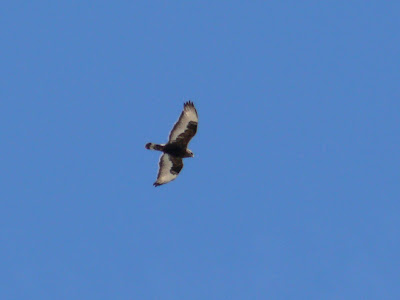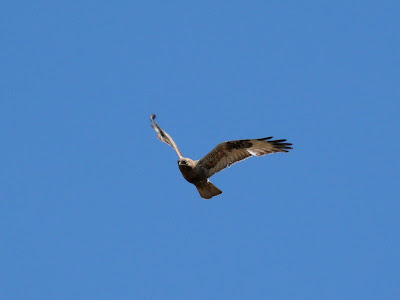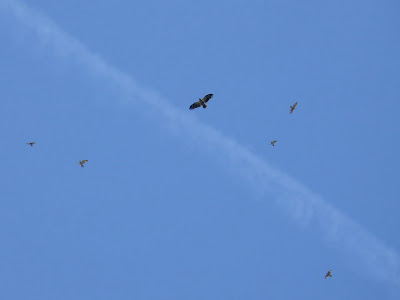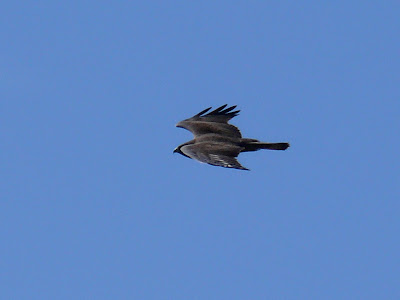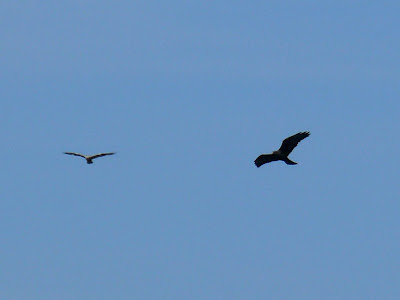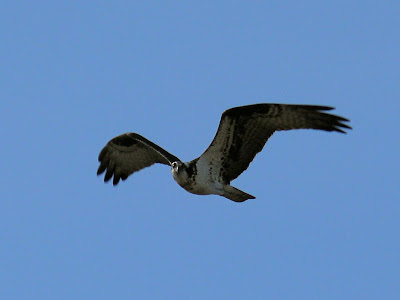
With still one day to go for the 2009 season, looking back on it might seem premature, but believe me: that last day is not going to make much of a difference. Hawk migration has been slow for a while now, with the last good raptor flight dating back to May 21.
Looking at the number of raptors counted for all species combined, 2009 was a slightly below average year. Over the last 20 years of counting, the average count for Whitefish Point is about 16,500 raptors. 2009 falls about 1,500 short of that average.
However, more species had a
better than average year than
below average. In fact, 6 species had a season with numbers well above average; 1 species was slightly above average; 4 species were about average; 1 species was slightly below average; and 4 species finally were well below average.
Better than average:The six species that fall in this category are Turkey Vulture, Bald Eagle, Northern Harrier, Red-shouldered Hawk, Golden Eagle and Peregrine Falcon.
Turkey Vulture numbers have increased at pretty much every Great Lakes and Northeastern hawk watch, as a result of a range expansion that probably started in the 1950s and is still ongoing. In the late 80s and early 90s, counts at Whitefish Point often stayed below the 100 mark. These days, seasonal counts of around 300 or 400 are the norm. 2009 so far had 368.
Bald Eagles are increasing after near-extinction only decades ago. 2009 ranks fifth in the series 1989-2008; all four previous years were (slightly) better.
The 2009 season also ranks fifth best for
Northern Harrier, with 520 counted this year, a few more than last year.
2009 is one of only five years in the last 21 that had more than 50
Red-shouldered Hawks. This year's total reached 57, a few more than last year.
This was easily one of the best years for
Golden Eagle (pictured above), second only to 2000, when 92 were counted. This year the count reached 89, many of them juveniles.
Peregrine Falcon too had a good year, with 58 for fourth best season ever. Another bird that's making a tremendous come-back after reaching near-extinction in the second half of the last century.
Slighty above averageThe
Rough-legged Hawk had a year with slightly above average numbers, about 12% more than average. The 2009 count got to 798.
AverageAll three accipiters had an average year. This actually comes as a bit of a surprise to me, because I thought that Sharp-shinned Hawk did poorly in 2009, while it seemed a good year for gos and coop's. Against long-term data (1989-2008), these three species however did just about average.
Sharp-shinned Hawk was 6% above average, while
Cooper's Hawk was 5% below average, and
Northern Goshawk 3% below average. I know that the raptor banders that band very close to the count site had one of their best Northern Goshawk years in recent memory, so it's curious to note the difference.
Swainson's Hawk also had an average year, with 2 counted.
Slightly below averageRed-tailed Hawk was slightly below average in 2009, by about 13%. Their count reached 1,308.
Below averageFor
Osprey, 2009 was well below average, by 55%. This is the second worst season on record for this species; only 2006 was worse, with 42. This year, 56 were counted. The average for Whitefish Point is 123.
Broad-winged Hawk had a low spring too in 2009, although the count was practically the same number as last year. It may be interesting to note that all three major North American count sites for this species - Lake Erie Metropark, Corpus Christi and Veracruz - had low numbers of broadwings last fall.
Finally, the two small falcons - American Kestrel and Merlin - had a low season this year. For
kestrel, less than half the number of last year were seen this year, and the count this year falls 37% short of the 20-year average. For
Merlin, a factor may have been that a pair had a territory very close to the hawk watch. I saw both adults constantly, and decided not to add sightings to the count when it was obviously one of these two birds, for example when the bird flew by calling loudly, or when it was seen flying back and forth constantly. Undoubtedly, some true migrants may have slipped through this way.
Tomorrow, when the season is officially over, I'll post the official count results here.
 Seven more raptors for the last day of the season, for a final total of 15,042 raptors this season. Two Turkey Vultures, one Bald Eagle, two Northern Harriers, a Northern Goshawk and a Peregrine Falcon were added to the count today.
Seven more raptors for the last day of the season, for a final total of 15,042 raptors this season. Two Turkey Vultures, one Bald Eagle, two Northern Harriers, a Northern Goshawk and a Peregrine Falcon were added to the count today.








